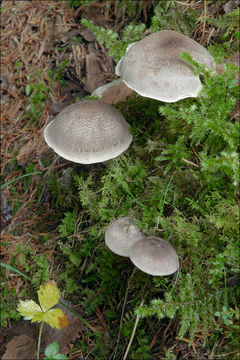Image of Tricholoma scalpturatum (Fr.) Quél. 1872

Description:
Slo.: rumenea kolobarnica - Habitat: bottom of an Alpine valley; steep slope at the edge of an old alluvial, grass covered terrace; edge of a large extensively used pasture; with scattered Picea abies, Betula pendula and Fagus sylvatica and different bushes; under Betula but also Picea trees not far; calcareous, sandy ground; mostly in shade; exposed to direct rain; average precipitations ~ 3.000 mm/year, average temperature 5-7 deg C, elevation 980 m (3.200 feet), alpine phytogeographical region. Substratum: sandy soil. Comments: Determination of gray to gray-brown Tricholoma species is (too?) difficult task for me. I considered two names for this find - Tricholoma scalpturatum and Tricholoma argyraceus Bull.. Breitenbach Ref.: 2 and Krieglsteiner Ref.:4 consider both as synonyms. Tricholoma monograph Ref.:6 doesn't treat Tricholoma argyraceus as an independent species but (only briefly) as a subspecies of Tricholoma scalpturatum. Contrary Index Fungorum and MycoBank consider both names as valid names of two independent species. As far as I was able to study this find it fits reasonably well to the traits of Tricholoma scalpturatum. However, the facts that observed yellowing of the stipe and lamellae (typical for T. scalpturatum but not for T. argyraceus, Ref.:6) was quite modest (see picture #5, right most pileus), that the mushrooms were found under Betula pendula (Ref.:7 lists this tree as a known mycorrhizal partner only for T. argyraceus) and that the measured average Q of the spores is 1.6 (according to Ref.:7 it should be: 1.3 < Q < 1.5 for T. scalpturatum and 1.5 < Q < 1.9 for T. scalpturatum) speak in favor of alternative and less common Tricholoma argyraceus. Probably only an elaborate microscopy would give an answer to this dilemma. Growing in scattered groups of several pilei, altogether more than thirty pilei; pilei diameter up to 4(5) cm; SP whitish, oac851. Spores smooth. Dimensions: 5 [5.6; 5.9] 6.5 x 3 [3.4; 3.6] 4 microns; Q = 1.4 [1.6; 1.7] 1.9; N = 30; C = 95%; Me = 5.7 x 3.5 microns; Qe = 1.6. Olympus CH20, NEA 100x/1.25, magnification 1.000 x, oil; in water, Congo red. AmScope MA500 digital camera. Herbarium: Mycotheca and lichen herbarium (LJU-Li) of Slovenian Forestry Institute, Vena pot 2, Ljubljana, Index Herbariorum LJF Ref.: (1) Personal communication with Mr. Bojan Rot, www.gobenabovskem.si. (1) R. Phillips, Mushrooms, Macmillan (2006), p 109. SP5-6/3-4* (2) J. Breitenbach, F. Kraenzlin, Eds., Fungi of Switzerland, Vol.3. Verlag Mykologia (1991), p 336. (3) S. Buczacki, Collins Fungi Guide, Collins (2012), p 156. (4) G.J. Krieglsteiner (Hrsg.), Die Grosspilze Baden-Wrttembergs, Band 3., Ulmer (2001), p 544. (5) R.M. Daehncke, 1200 Pilze in Farbfotos, AT Verlag (2009), p 260. (6) R. Galli, I Tricolomi, Atlante pratico-monografico per la determinazione del Genere Tricholoma, Edinatura (1999), p 118. (7) MycoBank, http://www.mycobank.org/
Included On The Following Pages:
- Life (creatures)
- Cellular (cellular organisms)
- Eukaryota (eukaryotes)
- Opisthokonta (opisthokonts)
- Nucletmycea
- Fungi (mushrooms, lichens, molds, yeasts and relatives)
- Dikarya
- Basidiomycota (basidiomycete fungi)
- Agaricomycetes (Mushroom-Forming Fungi)
- Agaricales (Gilled Fungi)
- Tricholomataceae
- Tricholoma
- Tricholoma scalpturatum
This image is not featured in any collections.
Source Information
- license
- cc-by-nc-sa-3.0
- copyright
- 2015 Dr. Amadej Trnkoczy
- photographer
- Dr. Amadej Trnkoczy
- original
- original media file
- visit source
- partner site
- CalPhotos
- ID


